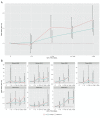Assessing the Association between Thermotolerant Coliforms in Drinking Water and Diarrhea: An Analysis of Individual-Level Data from Multiple Studies
- PMID: 27164618
- PMCID: PMC5047765
- DOI: 10.1289/EHP156
Assessing the Association between Thermotolerant Coliforms in Drinking Water and Diarrhea: An Analysis of Individual-Level Data from Multiple Studies
Abstract
Background: Fecally contaminated drinking water is believed to be a major contributor to the global burden of diarrheal disease and a leading cause of mortality among young children. However, recent systematic reviews and results from blinded studies of water quality interventions have raised questions about the risk associated with fecally contaminated water, particularly as measured by thermotolerant coliform (TTC) bacteria, a WHO-approved indicator of drinking water quality.
Objectives: We investigated the association between TTC in drinking water and diarrhea using data from seven previous studies.
Methods: We obtained individual-level data from available field studies that measured TTC levels in household-drinking water and reported prevalence of diarrhea among household members during the days prior to the visit.
Results: The combined data set included diarrhea prevalence for 26,518 individuals and 8,000 water samples from 4,017 households, yielding 45,052 observations. The odds of diarrhea increased for each log10 increase in TTC/100 mL by 18% (95% CI: 11, 26%) for children < 5 years old and 12% (95% CI: 8, 18%) for all ages. For all ages, the odds of diarrhea increased by 21%, 35% and 49% for those whose household water samples were from 11-100, 101-1,000, and > 1,000 TTC/100 mL, respectively compared to < 1 TTC/100 mL. We found no evidence of increased odds of diarrhea with contamination levels below 11 TTC/100 mL, either in adults or children.
Conclusions: Our analysis of individual-level data shows increased risk of diarrhea with increasing levels of TTC in drinking water. These results suggest an association between fecally contaminated water and diarrheal disease and provides support for health-based targets for levels of TTC in drinking water and for interventions to improve drinking water quality to prevent diarrhea.
Citation: Hodge J, Chang HH, Boisson S, Collin SM, Peletz R, Clasen T. 2016. Assessing the association between thermotolerant coliforms in drinking water and diarrhea: an analysis of individual level data from multiple studies. Environ Health Perspect 124:1560-1567; http://dx.doi.org/10.1289/EHP156.
Conflict of interest statement
The other authors declare they have no actual or potential competing financial interests.
Figures


References
-
- APHA (American Public Health Association), AWWA (American Water Works Association), WEF (Water Environment Federation) Washington DC: American Water Works Association; 2005. Standard Methods for the Examination of Water and Wastewater. 22nd ed.
LinkOut - more resources
Full Text Sources
Other Literature Sources

